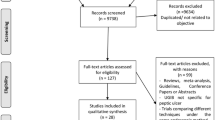Summary
Most episodes of haemorrhage from peptic ulcers cease spontaneously. A controlled trial designed to assess the efficacy of a new endoscopic treatment must answer 3 questions:
-
a)
can ulcers at high risk of further heamorrhage be identified endoscopically.
-
b)
is it technically possible to apply the new treatment to these high risk ulcers.
-
c)
does treatment influence the natural history.
Since 1981, 8 controlled trials have been reported of endoscopic laser therapy for haemorrhage from peptic ulcers. The protocols and conclusions varied, but when analysed in the same way, the results from all are consistent with each other. Further heamorrhage is most likely in ulcers with a visible vessel (bleeding or non-bleeding) seen in the crater at emergency endoscopy. About 75 % of rebleeds occur in ulcers accessible to laser therapy. Both Argon and Nd YAG lasers can reduce the incidence of rebleeding in ulcers with accessible visible vessels, but the results with the Nd YAG laser are more convincing. The most recent trial with the Nd YAG laser showed a significant reduction in rebleeding (p < 0.001), emergency surgery (p < 0.005) and mortality (p < 0.05). Few comparable trials have been reported with non-laser techniques although experimental studies with monopolar, bipolar and liquid electrodes and the heater probe are encouraging. Clinical trials to compare these with lasers are under way.
Résumé
La plupart des hémorragies d’origine ulcéreuse s’arrêtent spontanément. Une étude contrôlée pour apprécier l’efficacité d’une nouvelle méthode de traitement par voie endoscopique doit répondre à trois questions:
-
a)
peut-on identifier les ulcères à hauts risques de persistance hémorragique sur des critères endoscopiques ?
-
b)
est-il possible sur le plan technique d’appliquer ce nouveau traitement à ces ulcères à hauts risques ?
-
c)
est-ce que ce traitement influence l’histoire naturelle?
Depuis 1981, 8 études contrôlées ont été rapportées concernant le laser par voie endoscopique pour le traitement des ulcères hémorragiques. Les protocoles et des conclusions de ces essais varient mais lorsqu’on les analyse on s’aperçoit qu’il n’y a pas de différence fondamentale entre eux. La persistance de l’hémorragie semble plus fréquente lorsqu’il existe un vaisseau visible à l’endoscopie. Environ 75 % des récidives hémorragiques concernent des ulcères accessibles à la photocoagulation. L’Argon et le Néodyme YAG laser peuvent réduire l’incidence des récidives ulcéreuses lorsqu’il existe un vaisseau visible mais les résultats semble plus convainquant avec le Néodyme YAG. Le dernier essai avec le Néodyme YAG montre une diminution significative des récidives (p < 0,001) de la chirurgie d’urgence (p < 0,005) et de la mortalité (p < 0,05). Peu d’essais analogues ont été rapportés avec des techniques autres que le laser bien que des études expérimentales avec l’électrocoagulation monopolaire, bipolaire ou en milieu liquide et avec la sonde chauffante n’aient montré que des résultats encourageants. Des essais cliniques pour comparer ces méthodes avec des lasers sont actuellement en cours.
Similar content being viewed by others
Références
BOWN S.G., SALMON P.R., STOREY D.W. et al. - Nd YAG laser photocoagulation in the dog stomach.Gut, 1980,21, 818–825.
Escourrou J., Frexinos J., Bommelaer G. et al. -Prospective randomised study of YAG photocoagulation in gastrointestinal bleeding. Proceedings of Laser Tokyo’ 81. Ed. Atsumi K. and Nimsakul N., 1981, 5–30.
FOSTER N.D., MILOSZEWSKI K.J.A., LOSOWSKY M.S. - Stigmata of recent haemorrhage in diagnosis and prognosis of upper gastrointestinal bleeding.Br. Med. J., 1978,l, 1173–1177.
GRIFFITHS W.J., NEUMANN D.A., WELSH J.D. - The visible vessie as an indicator of uncontrolled or recurrent gastrointestinal haemorrhage.N. Eng. J. Med., 1979, 300,1, 411–413.
IHRE T. JOHANSSON C., SELIGSON U. et al. - Endoscopic Y. A.G. laser treatment in massive upper gastrointestinal bleeding.Scan. J. Gastroenterol, 1981,16, 633–640.
JENSEN D.M., MACHICADO G.A., SILPA M.L. - Argon laser vs Heater Probe or Bicap for control of severe ulcer bleeding.Gastrointest. Endosc, 1984,30, 2, 134.
JONES P.F., JOHNSTON S.J., McEWAN A.B. et al. - Further haemorrhage after admission to hospital for gastrointestinal haemorrhage.Br. Med. J., 1973,3, 660–664.
KIEFHABER P., NATH G., MORITZ K. - Endoscopic control of massive gastrointestinal haemorrhage by irradiation with a high power Nd YAG laser.Prog. Surg., 1977,15, 140–155.
LAURENCE B.H., VALLON A.G., COTTON P.B. et al. - Endoscopie laser photocoagulation for bleeding peptic ulcers.Lancet, 1980,l, 124–125.
MACLEOD I., MILLS P.R., MACKENZIE J.F. et al. - Neodymium YAG.laser photocoagulation for major haemorrhage from peptic ulcers and single vessels.Br. Med. J., 1983,286, 345–348.
Papp J.P. -Electrocoagulation. In: Endoscopie control of gastrointestinal haemorrhage. J.P. Papp, Editor.C.R.C. Press, 1981, 31–42.
RUTGEERTS P., VANTRAPPEN G., BROECKHAERT L. et al. - Controlled trial of YAG laser treatment of upper digestive haemorrhage.Gastroenterology, 1982,83, 410–416.
STOREY D.W., BOWN S.G., SWAIN C.P. et al. - Endoscopie prediction of recurrent bleeding in peptic ulcers.N. Eng. J. Med., 1981,305, 915–916.
SWAIN C.P., BOWN S.G., SALMON P.R. et al. - Controlled trial of Nd YAG laser photocoagulation in bleeding peptic ulcers.Gastrointest. Endosc, 1984,30, 2, 137.
SWAIN C.P., BOWN S.G., STOREY D.W. et al. - Controlled trial of Argon laser photocoagulation in bleeding peptic ulcers.Lancet, 1981,ii, 1313–1316.
SWAIN C.P., MILLS T.N., SHEMESH E. et al. - Which electrode ? - A comparison of four endoscopie methods of electrocoagulation in experimental bleeding ulcers,Gut, 1984,25, 1424–1431.
VALLON A.G., COTTON P.B., LAURENCE B.H. et al. - Randomised trial of endoscopie Argon laser photocoagulation in bleeding peptic ulcers.Gut, 1981,22, 228–233.
Author information
Authors and Affiliations
About this article
Cite this article
Bown, S.G. Controlled studies of laser therapy for haemorrhage from peptic ulcers. Acta Endosc 15, 1–12 (1985). https://doi.org/10.1007/BF02966108
Issue Date:
DOI: https://doi.org/10.1007/BF02966108




